The Voskhod 2 mission revisited
Sven Grahn
17
March
1965 - Rumours in Moscow
The Kosmos-57
spacecraft was launched on 22 February 1965 to test the
airlock.
It was destroyed due to a procedural error by ground stations, but the
data gathered on the functioning of the airlock was sufficient to clear
the way for a manned launch in the period 15-20 March. This success
created
the first wave of rumours on 24 February about an upcoming manned space
launch (6). Kosmos-59, a Zenit
reconnaissance
satellite, was launched on 7 March verifying that the airlock
attachment
ring would not affect re-entry and landing (1).
The State Commission met on 16 March to decide that the launch would
take
place on 18 March at 0700 UT. Obviously, the results of the State
Commission
meeting was leaked, perhaps deliberately, to media in Moscow, because
on
17 March 1965 intense rumours were circulating in Moscow about the
imminent
launch of a manned spacecraft, called a "space bus" in the rumours (5).
18
March
1965 - Launch and exit into space
Leonov's EVA
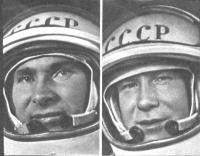 The
Voskhod 2 spacecraft carrying Pavel Belyayev and Alexei Leonov was
launched
at 0700 UT from Baikonur and put into a 169-473 km orbit at 64.8 degree
inclination and a period of 90.9 minutes. News agencies cabled the news
to the world at 0754 UT. By that time Alexei Leonov had already made
his
exit into space and was back inside the spacecraft (see map below). The
exit into space took place just before reaching the radio horizon of
the
ground station at Yevpatoria in the Crimea. It was this station that
picked
up the TV image of Leonov "swimming" in space that TV viewers all over
the world could see later that day. Of course we now know about all the
difficulties Leonov had to squeeze himself back into the inflatable
airlock.
It took Leonov 10-12 minutes to re-enter the airlock and he got back
inside
just in time for the spacecraft's pass over the ground stations in the
Soviet Far East.
The
Voskhod 2 spacecraft carrying Pavel Belyayev and Alexei Leonov was
launched
at 0700 UT from Baikonur and put into a 169-473 km orbit at 64.8 degree
inclination and a period of 90.9 minutes. News agencies cabled the news
to the world at 0754 UT. By that time Alexei Leonov had already made
his
exit into space and was back inside the spacecraft (see map below). The
exit into space took place just before reaching the radio horizon of
the
ground station at Yevpatoria in the Crimea. It was this station that
picked
up the TV image of Leonov "swimming" in space that TV viewers all over
the world could see later that day. Of course we now know about all the
difficulties Leonov had to squeeze himself back into the inflatable
airlock.
It took Leonov 10-12 minutes to re-enter the airlock and he got back
inside
just in time for the spacecraft's pass over the ground stations in the
Soviet Far East.
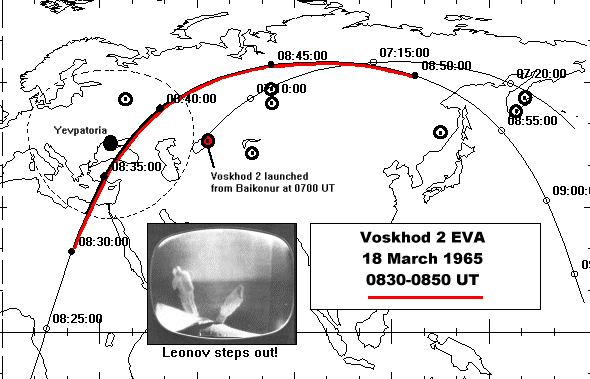
Short-wave
Telemetry Monitoring in the West
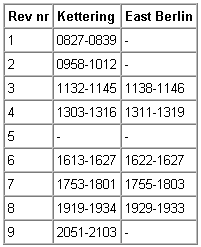 Voskhod
2 was announced by TASS as transmitting voice on 143.625 MHz, 18.035
MHz
and 17.365 MHz and having a "Signal" beacon transmitter on 19.996 MHz.
Of course the 143.625 MHz FM transmissions were used for line-of-sight
communications with ground stations while the short-wave frequencies
were
used to communicate with the spacecraft when it was far from Soviet
territory.
It also seems that 18.035 and 17.365 MHz was used in the simplex
mode, i.e. the ground stations used the same frequencies for their
calls
to the crew in space.
Voskhod
2 was announced by TASS as transmitting voice on 143.625 MHz, 18.035
MHz
and 17.365 MHz and having a "Signal" beacon transmitter on 19.996 MHz.
Of course the 143.625 MHz FM transmissions were used for line-of-sight
communications with ground stations while the short-wave frequencies
were
used to communicate with the spacecraft when it was far from Soviet
territory.
It also seems that 18.035 and 17.365 MHz was used in the simplex
mode, i.e. the ground stations used the same frequencies for their
calls
to the crew in space.
Plenty of short-wave
signals
were indeed picked up in Western Europe and the United States
during
18 March 1965. The monitoring post at Kettering Grammar School run by
Geoff
Perry certainly received the "Signal" radio beacon on shortwaves
throughout
the day and the same was true at the "Junge
Welt" (Young World) listening post of the East German
Astronautical
Society (Deutsche Astronautische Gesellschaft) in Berlin headed by
Karl-Heinz
Neumann. The receptions of these stations are summarized in the table
on
the right and in the map below.
The the "Signal"
telemetry
was transmitted on 19.996 MHz and consisted of a frequency-shift-keyed
carrier where the pulses at the lower frequency represented heart rate
(pulse frequency) and respiration (pulse duration) in the manner
explained
in "Biomedical
telemetry".
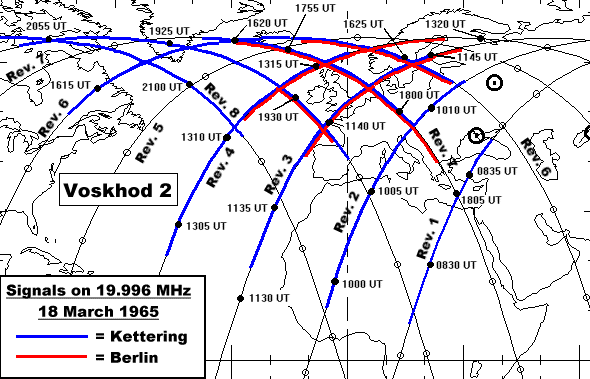
The short piece of
signal
shown in the graph below was recorded in Kettering on rev 7 and one can
see that the heart rate is approximately 86 beats per minute and the
respiration
rate is 20 per minute (Click here
to
see the respiration signal plotted). Click on the graph
below to listen to the signal. (mp3 file)
 Biomedical
telemetry
on 19.996 MHz as picked up by the Kettering Grammar School on rev 7
just
before
Biomedical
telemetry
on 19.996 MHz as picked up by the Kettering Grammar School on rev 7
just
before
1800 UT on 18 March
1965.
(Ordinate = frequency in Hz, Abscissa = Time in seconds)
|
Short-wave
Voice Monitoring in the West
Voice from Voskhod 2 was
picked
up in Sweden by the telecommunication administration's spectrum
monitoring
station in Enkoping at 1316-1318 UT on 17.365 MHz. The SOHIO Research
Center
in Cleveland, Ohio picked up voice from Voskhod 2 on 18.035 MHz on rev
6 and 7.
19
March
1965 - going an extra orbit and landing in the taiga
As the spacecraft came
within
range of the Soviet VHF ground stations in the far East on
revolution
13 the crew reported the pressure in the air bottles had dropped from
75
to 25 atmospheres (1). This was a potential
threat to the mission but the pressure stabilized at 25 atmosphere as
the
crew could report on the following revolution.
Failure
of the automatic descent system
During the 16 th
revolution
the automatic landing system was programmed from the ground by sending
commands, probably from tracking stations in the Far East. Command
"number
6" did not go through reportedly due to a fault in the solar
orientation
system (3). It is unclear when the
decision
to go to the manual descent system was taken because orders to the crew
to use the manual descent system kept being sent as the craft came in
over
Africa at the beginning of the 17 revolution, quite some time after the
intended retrofire point.
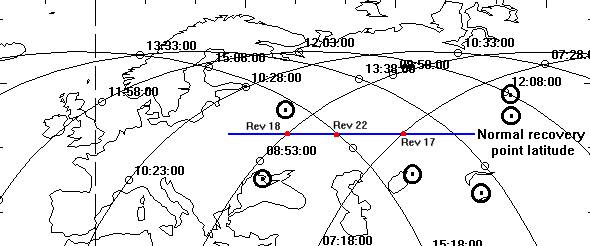
Orders
for manual descent issued on shortwaves
Belyayev was ordered to
use
manual procedures for orienting the ship and firing its retrorockets on
either the 18th or 22st revolution. The intended landing points were
probably
all located at about 52 degrees North where most recoveries of Soviet
recoverable
satellites took place (See map above). At 0716 UT on 19 March 1965
Western
space listeners could hear the
ground station Vjezna
3 (Spring 3) tell the crew (Almaz) to use manual descent. "Almaz,
Almaz, this is Vjezna-3, this is Vjezna-3. The circuit for the
automatic
descent orientation system has been (shall be?) switched off
(deactivated)
and the system to control the descent manually is (shall be?) switched
on." The crew responded
on the same
voice frequency (17.365 MHz) and was asked to also respond by Morse
code.It
is interesting that the ground informs the crew at this point, when
retrofire
should have occurred. Probably the commands to program the retrofire
were
supposed to have been uplinked from the stations in Kamchatka, but that
the commands did not go through. As can be seen from the map below the
short-wave call went out only about five minutes before the craft would
come into VHF range of ground stations in the Soviet Union. The message
was indeed urgent! At
0732 UT voice from Voskhod 2 was again heard by the Swedish monitoring
station at Enkoping and at 0747 UT and again at 0750 UT the German
monitoring
station at Bochum could hear the ground order manual descent but no
reply
from the crew could be heard! The spacecraft was over the Pacific (See
map below).
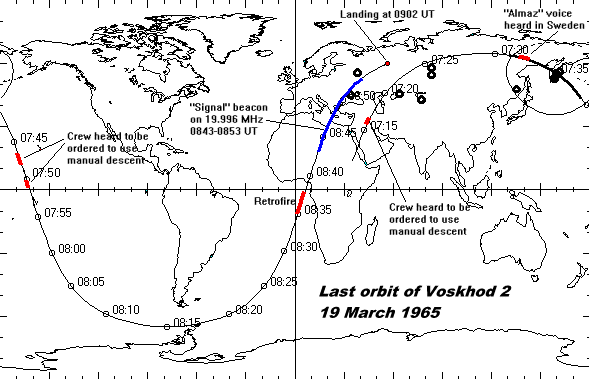
<>
At 0840 UT the beacon on
19.996 MHz was again picked up by space listeners in Western Europe and
they faded out at 0853 UT. The
crew used the Vzor to orient the craft but this kept them out of their
seats which delayed retrofire by 46 seconds, which (coupled with an
incorrect
attitude...?) led to a 2000 km overshoot in the landing point location.
According to some sources the service module failed to separate
completely
until connecting wires burned through during re-entry. The craft
finally
landed in Ural mountains at 59:34 N 55:28 E at 09:02 UT.
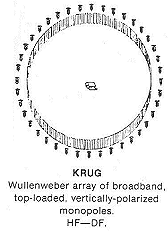 General
Kamanin described the landing phase in his diary (7):
General
Kamanin described the landing phase in his diary (7):
"We received the
first
report of the spacecraft's descent rather quickly, from Odessa and
Saransk
[both directly under the path of the spacecraft. Saransk located at 54
deg 12 min North, 45 deg 10 min East. S.G], but we had no reliable
information
as to the condition of the crew for four long hours. True the 'Krugi'
radio stations had located the craft, and Alma-Ata has received a
telegrapgh
code several times via HF channel: 'VN...VN...VN' (this was a signal
from
the crew, meaning 'everything normal' [vsyo normalno]). It was nice to
have the radio fix and the 'VN' signals, but we wanted more convincing
data as to the condition of the cosmonauts. Finally, to the joy of
everyone,
came the long-awaited report of the commander of one of the search
helicopters:
'On the forest road between the villages of Sorokovaya and Shchuchino,
about 30 kilometers southwest of the town of Berezniki, I see the red
parachute
and the two cosmonauts. there is deep snow all around.....'...."
"KRUG" is the
code
name for a Soviet direction finding circular antenna array ("Krug"
means
"Circle" in Russian). See picture on the right from page 263 of
the
1976-77 issue of the International Countermeasures Handbook. The
frequency
of the beacon that the Krug antennas picked up was probably 10.003 MHz
(8). The beacon system was called "Peleng"
or
P-37(8).
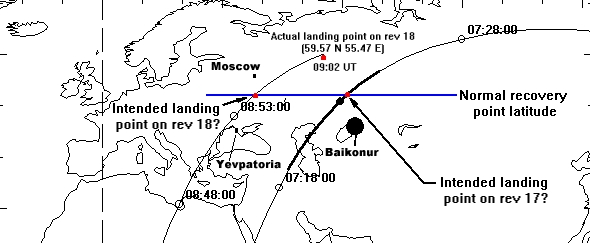
The
landing
announced and the return of the crew to civilization
Throughout midday Radio
Moscow
was broadcasting music and interrupted the music several times as if to
make an announcement. At first, just after the the expected landing
time,
the music was quite jolly, but gradually the music became more sombre
(including
Tjajkovsky's first piano concerto) as if preparing listeners for bad
news
(4).
Finally, at 1344 UT, news of the landing was broadcast
by the famous announcer Yuri Levitan on Radio Moscow.
The spacecraft had
landed
in deep snow wedged between two fir trees (2).
The first recovery helicopter spotted them around 1300 UT (just 45
minutes
before the announcement by Levitan) and could confirm that they were
alive
and well (1). The helicopter could not
land
because of the thick forest. Around 1700 UT a helicopter was able to
land
about 5 km from the capsule, but a search party could not reach the
crew.
Warm clothes and supplies were air dropped to the crew. The crew spent
the night in the woods, surrounded by wolves (some say). The next
morning
at 0430 UT a team of rescuers were dropped 1.5 km from the capsule but
it took another 4 hours for them to reach the Voskhod 2 crew. It was
considered
too risky to lift the crew to a hovering helicopter, so the crew had to
spend another night in the taiga, in the company fo some 20 rescuers. A
helicopter landing zone was cleared at 1.7 km from the capsule and
another
at 5 km distance. By 0500 UT the following morning (21 March) the
cosmonauts
skied to nearest landing zone, were airlifted to the second spot and
from
there flown in a big helicopter to the Perm airport where they were
reached
by a phone message from Leonid Brezhnev. They then boarded a plane and
reached Baikonur at 1430 more than 48 hours after the landing!
References
-
Hendrickx,
Bart, "Kamanin Diaries 1964-66". Journal of the British
Interplanetary
Society, Vol 51, No 11, November 1998, pp 422-423.
-
Harford,
James, "Korolev - how one man masterminded the Soviet drive to beat
America to the Moon", John Wiley & Sons, 1997, pp 185-186
-
Romanov,
A. "Spacecraft Designer, the story of Sergei Korolev", Novosti
Publishing
House, Moscow, 1976, p.97.
-
Perry,
Geoff, Personal communication, 16 January 1999.
-
Stockholms-Tidningen
(Swedish daily newspaper published in the morning), Thursday 18 March
1965,
under the headline "Space Bus ready for launch"
-
Svenska
Dagbladet (Swedish daily newspaper published in the morning),
Thursday
25 February, under the headline "Space Rumours"
-
Sovetskaya
Rossiya, "Pages from a Diary. He soared freely above the earth: On
the 25 th Anniversary of the Flight of Pilot-Cosmonauts P.I. Belyayev
and
A. A. Leonov in the Voskhod-2 and the First Spacewalk", 17 March 1990,
p. 6
-
N.P.
Kamanin:
Diary Entry for 9 March 1961. Translated by C.M. van den Berg.

 Back
to Space History Notes
Back
to Space History Notes

 The
Voskhod 2 spacecraft carrying Pavel Belyayev and Alexei Leonov was
launched
at 0700 UT from Baikonur and put into a 169-473 km orbit at 64.8 degree
inclination and a period of 90.9 minutes. News agencies cabled the news
to the world at 0754 UT. By that time Alexei Leonov had already made
his
exit into space and was back inside the spacecraft (see map below). The
exit into space took place just before reaching the radio horizon of
the
ground station at Yevpatoria in the Crimea. It was this station that
picked
up the TV image of Leonov "swimming" in space that TV viewers all over
the world could see later that day. Of course we now know about all the
difficulties Leonov had to squeeze himself back into the inflatable
airlock.
It took Leonov 10-12 minutes to re-enter the airlock and he got back
inside
just in time for the spacecraft's pass over the ground stations in the
Soviet Far East.
The
Voskhod 2 spacecraft carrying Pavel Belyayev and Alexei Leonov was
launched
at 0700 UT from Baikonur and put into a 169-473 km orbit at 64.8 degree
inclination and a period of 90.9 minutes. News agencies cabled the news
to the world at 0754 UT. By that time Alexei Leonov had already made
his
exit into space and was back inside the spacecraft (see map below). The
exit into space took place just before reaching the radio horizon of
the
ground station at Yevpatoria in the Crimea. It was this station that
picked
up the TV image of Leonov "swimming" in space that TV viewers all over
the world could see later that day. Of course we now know about all the
difficulties Leonov had to squeeze himself back into the inflatable
airlock.
It took Leonov 10-12 minutes to re-enter the airlock and he got back
inside
just in time for the spacecraft's pass over the ground stations in the
Soviet Far East.

 Voskhod
2 was announced by TASS as transmitting voice on 143.625 MHz, 18.035
MHz
and 17.365 MHz and having a "Signal" beacon transmitter on 19.996 MHz.
Of course the 143.625 MHz FM transmissions were used for line-of-sight
communications with ground stations while the short-wave frequencies
were
used to communicate with the spacecraft when it was far from Soviet
territory.
It also seems that 18.035 and 17.365 MHz was used in the simplex
mode, i.e. the ground stations used the same frequencies for their
calls
to the crew in space.
Voskhod
2 was announced by TASS as transmitting voice on 143.625 MHz, 18.035
MHz
and 17.365 MHz and having a "Signal" beacon transmitter on 19.996 MHz.
Of course the 143.625 MHz FM transmissions were used for line-of-sight
communications with ground stations while the short-wave frequencies
were
used to communicate with the spacecraft when it was far from Soviet
territory.
It also seems that 18.035 and 17.365 MHz was used in the simplex
mode, i.e. the ground stations used the same frequencies for their
calls
to the crew in space.




 General
Kamanin described the landing phase in his diary (7):
General
Kamanin described the landing phase in his diary (7):
